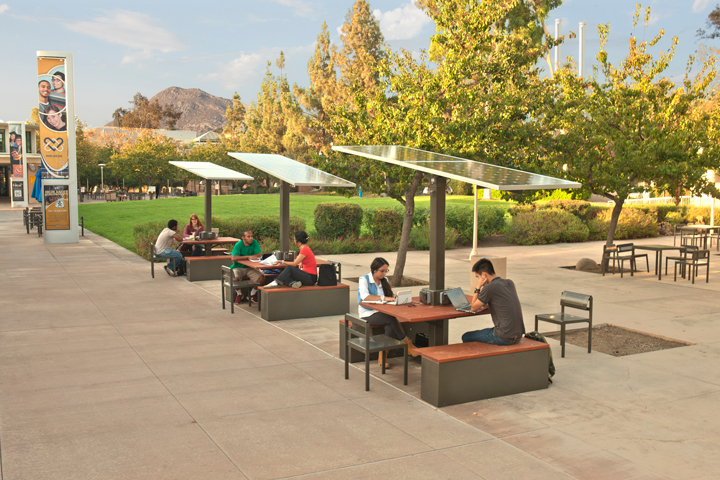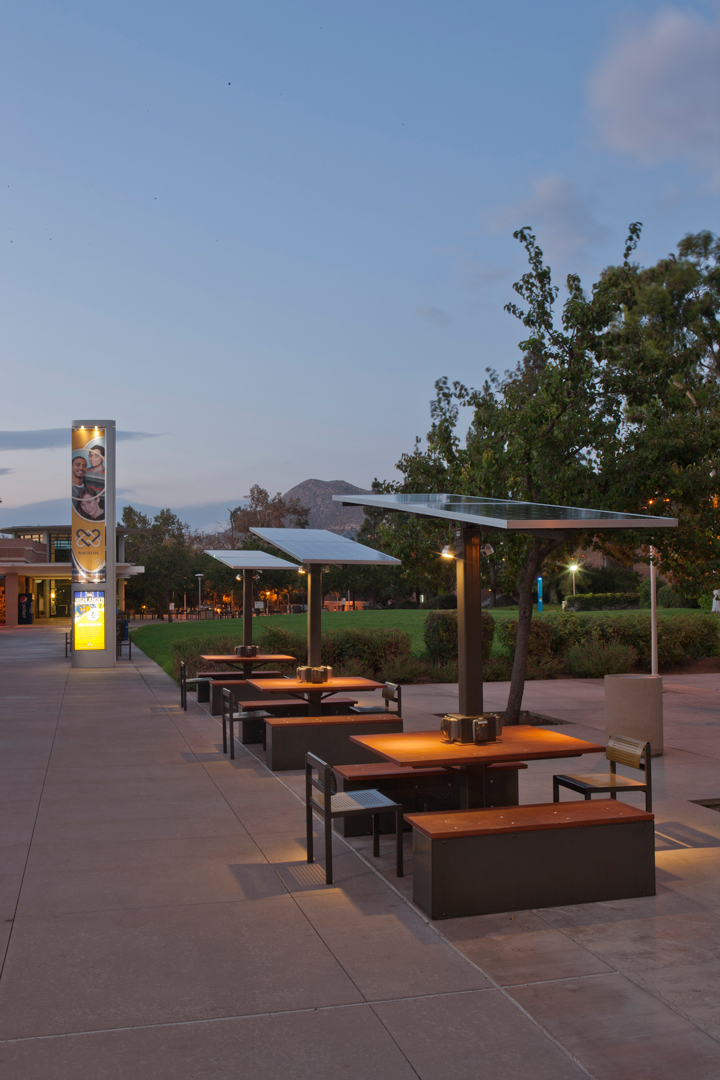A certain creatively charged atmosphere is generated by people hanging out and charging their phones—its an environment that can create a market opportunity for public-space owners who want to attract people to linger at their sites.
Off-grid Solar-Powered Charging Stations
Jim Innes | CarrierClass
Where do off grid solar charging stations fit into the spectrum of solar installations and infrastructure?
I like to think of solar-powered charging stations as ambassadors of green goodwill, they offer a green amenity that provides facility, value and easy accessibility. In fact, I’d argue that solar panels are the single most visible symbol of the green movement—particularly the panel’s iconic blue sunlight reflection which connects the user to the power-generation process; he witnesses the transformation of sunlight to electricity.

Before the first solar-powered charging stations rolled out in 2012, solar-powered infrastructures in public places remained largely invisible to public-space users. They were usually limited to small panels that power lights and utility devices-- none of which were placed in high-visibility areas—and so only green-oriented people would notice them in public spaces.
The introduction of the first solar-charging table in 2013—what I called solar-green infrastructure—offered a tangible hands-on way to charge handheld electronic devices in a public spaces. Manufactured by our company, CarrierClass Green Infrastructure (CCGI), the ConnecTable Café and Hub solar-charging stations offer a true site amenity: that is, a device that provides a facility and value to the user. Solar-charging stations are the only solar-powered amenity that provides a high value-of-use benefit. As such, they provide green awareness and green utility.
What types of customers and facilities are best suited for solar charging stations?
Customers and facilities best-suited for solar-charging stations usually own or manage medium to high volume use public spaces —or public spaces that owners are looking to attract or grow additional traffic. Solar powered charging stations engage the users of any busy public space and create positive incentives for people to further engage with that space, its other amenities, and other users as well.

A certain creatively charged atmosphere is generated by people hanging out and charging their phones—it’s an environment that can create a market opportunity for public-space owners who want to attract people to linger at their sites. It’s the “pied piper” effect—one person starts charging their phone or tablet and many other follow.
What are the benefits to the facility at which charging stations are installed?
A solar charging station is a natural focal point for people to gather and interact while they’re using the station. The goal is to bring more traffic, protect the owner’s green image, and use this to enhance spaces that are otherwise under use. Furthermore, if a site owner is a particular “green” type, the table serves as a powerful visible ambassador for their green policy. Often the only green presence on a corporate grounds or campus quad is green recycling garbage cans. Solar-charging stations offer a vivid clear positive and aesthetically pleasing symbol of our green commitment—without overemphasizing a green policy.
Colleges and universities were the original pioneering early adopter customer for robust off-grid solar mobile device charging stations. For this sector, high quality charging stations such as ConnecTable solar-charging-stations tables fulfilled all of the requirements:
1. Provides reliable high volume mobile device charging on 24/7/365 day basis in all conditions
2. Offers a comfortable outdoor workspace setting for university students and staff for educational and social activities alike.
3. Provides a vivid and highly visible symbol of the institutions commitment to sustainability and green practices
4. Offers a hands-on positive solar experience to each user that also maximizes their use and enjoyment of the surrounding space. Also: solar charging tables provide utility.
What surprises your customers and their onsite community the most after their initial installation?
We rolled out the ConnecTable Café table in 2012, officially by doing the prototype at Green Build—and, soon after, the University of California, Riverside (UCR) gave us our first order.
Consistently ranked as one of the most ethnically and economically diverse universities in the United States, the University of California, Riverside (UCR) is a large commuter school—with plenty of students looking for places to hangout between classes. Beyond that, the college’s dormitories are more than a half mile away—so even if you’re not a commuter, you don’t want to run home to charge your phone. UCR prides itself on green environmental policies, as well as its Center for Environmental Research and Technology and Air Pollution Research Center.
It was a big shock to everyone how much use the tables got, even as they were being installed students and faculty were crowding the table to see what they were and when they could start using them. Even today as you are on UCR’s campus, you will be hard pressed to find a spot at one of the tables!
Public-relations may end up being the tipping point for off-grid charging stations. Colleges, which tend to be early adopters of progressive change, are especially looking for visible ways to show their green commitment. And where’s a better place to demonstrate green goodwill than a campus green?
Do they require a lot of maintenance and care?
Solar charging stations generally are very robust structures that withstand all of the usual environmental and user wear and tear—they’re built for the long-term to last. Our solar-charging tables are commercial grade code-compliant, highly reliable and highly autonomous. They’re made of structural steel and structural-grade powder coating, with high-grade components. With our standard of quality, maintenance is minimal. The only maintenance is keeping them clean—wiping off pollen, dust, etc. Exterior wash down or wipe down—like anything else.
Considering all the advantage of implementing onsite grid tied solar PV, the complexities of siting, design, and permitting can be daunting. Do solar charging stations require much of the same?
Probably the single best thing about solar-charging tables is that they don’t require the daunting siting, design and permitting complexities of implementing onsite infrastructures. The core design of our Café and Hub ConnecTable charging stations was borne of experience, so we made it as simple and durable as possible.
Is ideal solar access a requirement to meet typical high traffic/high mobile device use on campus?
A true off-grid solar system is always designed to provide power to a specific defined load. Both the ConnecTable Café & Hub models need just an average of about six hours of sun over every three-day period so it can meet a mobile-device charging “reliability” objective of charging. The Café contains a 3/1 input/output power ratio designed for optimized battery recharge and autonomy so it provides reliable charging year-round, even in cloudy conditions
What level of mobile device charging reliability and off grid solar system autonomy performance is best for high traffic campus environments?
The ConnecTable charges 75 to 100 iPhone 5/6 equivalent devices per day. No other manufactured off-grid solar charging table currently available meets this standard. In addition, ConnecTables are unique in that they offer USB and 120 volt charging. USBs are ideal for charging phones and tablets, while 120V is needed for charging laptops, tablet computers, and other portable devices such as projectors and powered speaker system. And since ConnecTables are true 100% off grid solar powered, in the event of a campus wide power outage, these stations will continue to operate and provide mobile device charging power with as little as 2 hours of good sunlight on a daily basis.
I like to think the ConnecTable presents a miniature version of a solar farm—with vibrant color and images. The tables operate autonomously and maintenance-free year round through the most extreme weather conditions—rain, snow, ice, hail—and, most importantly, during power outages. All in all, ConnecTable’s simple, elegant design is one that warms the cockles of any environmentalist’s heart.

Jim Innes (CEO) - With CarrierClass Green Infrastructure, Jim embarks on his fourth business venture in developing critical infrastructure. Jim has played an active role in expanding the Northeast's telecommunications infrastructure. Since 1985, Jim has managed the turnkey operations of high capacity microwave backhaul projects. He’s an acknowledged expert in antenna site management as well, having worked extensively with both rooftop site and nationwide tower inventories. His passion for sustainability led to a career expansion in solar PV projects. Working with solar led to the idea for the ConnecTable; it is Jim’s mission to provide off-grid, sustainable charging for nearly any location across the globe.
The content & opinions in this article are the author’s and do not necessarily represent the views of AltEnergyMag
Comments (0)
This post does not have any comments. Be the first to leave a comment below.
Featured Product

